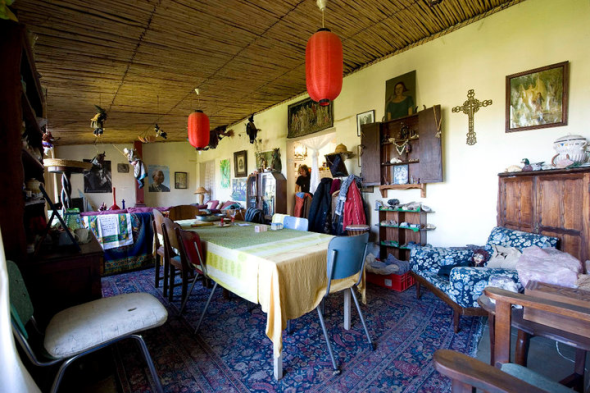 I I am hardly out of the car, and Guiseppe is there to welcome me with an all encompassing bear hug. We haven’t seen each other for seven years. He’s an unusual character; not exactly eccentric, certainly unconventional, always big-hearted.
I I am hardly out of the car, and Guiseppe is there to welcome me with an all encompassing bear hug. We haven’t seen each other for seven years. He’s an unusual character; not exactly eccentric, certainly unconventional, always big-hearted.
Guiseppe Massolini was born in Dar es Salaam. His step-great grandfather (who passed away in 1976) was originally a Sikh. He cut off his kesh and turned Catholic, to marry and take care of the Italian widow he had fallen in love with and her 11 kids. Something about the romance of that act still informs Massolini’s life.
I met chef Guiseppe (he doesn’t care for being called Mr Massolini) in the 1990s, when he ran a very popular supper club in an old house on Buitenkant Street. I know many Capetonians who still pine for those celebrated evenings. The place was crammed with Art Deco furniture and light fittings. Three nights a week, he would have two tables with around 30 guests. It was fully booked for six months in advance. I’d stand in the kitchen (where he taught me to make potato gnocchi), paging hopefully through the reservation book, looking for an open seat. Sometimes, I’d simply end up in the scullery.
One day, I discovered Guiseppe had sprouted a large tattoo. Shortly afterwards, he sold up Buitenkant Street and moved to Barrydale – gateway to the alternative Karoo. We lost touch.
It is exhilarating to report that he is now back on the gastronomic circuit with a “supper club” that serves lunch. These lunches frequently end with a tarot card reading.
As long as I’ve known him, Guiseppe is teetotal, but that doesn’t stop the Paarl locals from affectionately calling him ‘Gesuipie’.
Guiseppe’s home is off the R101 on the Belair farm, which has a luxury guesthouse complete with Lombardy poplars and a full-size Chartres labyrinth of yellow gazanias. The farm was once a racehorse stud and home to multiple winner, Occult, the only South African-bred horse to win the coveted treble: Republic Day, Durban July and Gold Cup. You’ll find Guiseppe in the converted stables.
The driveway is bordered by lemon trees – the sweetish, wrinkly-skinned Cape lemons that turn orange, and the smooth Eureka strain.
Guiseppe leads me in through the back. The entrance has a peach pip floor. “You should take off your shoes, it gives a wonderful foot massage,” he says.
The grounds are populated by angels, Buddhas and garden gnomes. Guiseppe makes his own Madonnas and sculptures out of cement. To the rear is the folly, a mock classical Greek ruin with pillars. Granadilla vines shade an outside table. Hadedas and sacred ibis fly overhead. “Nature is my divinity,” he says.
In his permaculture garden, Guiseppe grows some of his vegetables, including tomatoes, bell peppers and a variety of bitter, reddish lettuce. He tries to source all his produce from within a 10km radius in the slow food way, though in Italy this is far easier to do. His cheeses come from Zandam, among the first local producers to make mozzarella, ricotta and provolone in South Africa.
The kitchen is a long, narrow galley. My eye falls on a photo of Guiseppe in uniform during his army year in Italy; he is putting on a brave face.
Together with 27 dolls of witches, his granny’s gorgeous, Art Deco, pink seashell light from Dar es Salaam, hangs from the ceiling in the informal dining room. The bric-a brac furnishings include Art Deco cabinets and chairs, and a 1960s Formica table graced with a vase of tall arum lilies. In winter, the fireplace is lit; in summer, it is possible to dine outside on hot days.
What little space is left, I must now dedicate to his glorious food. The antipasto is grilled crostini “alla moda” topped with pimento olives and tomato paste.
For his home-baked ciabattas, Guiseppe is particular about using Eureka Mills’ slow, stone-ground flours from wheat grown by crop-rotation and good-tillage practices.
His much-admired mains are: a “big fat” green risotto, with broccoli, spinach, zucchini and gorgonzola; homemade potato gnocchi with pancetta, chilli and tomato; osso buco alla gremolata; slow-roasted loin of pork cooked in sweet wine with caramelized Golden Delicious apples.
A typical set menu includes two salads. We had fresh lettuce with fennel bulb and an outsized green salad with balls of boccini cheese.
You need to pace yourself, as desserts are a strong point. There is double-chocolate tart, a sort of death alla Venezia; almond and butter tartlets; the type of strudel with which Marie Antoinette bankrupted the monarchy – pears, pink apples, cinnamon cloves in a pastry, with custard and gooseberries, blueberries and strawberries, with swamp mint and satsuma (a kind of naartjie), and garnished with lavender.
To wend one on one’s way, Guiseppe pours bottomless rounds of espresso, and offers plates of almond, apricot, and cherry biscotti.
Guiseppe’s Italian catering. Book three weeks in advance. R200 per person. A minimum of eight, a maximum of twelve guests. Arrive at noon, eat from 1pm “until whenever”. BYOB (bring your own bottle) basis. A donation for tree planting is always welcome. Over a hundred trees have been planted through this effort already. Tel: 021-863 1187.
This article appeared in the Mail & Guardian September 17, 2010.
